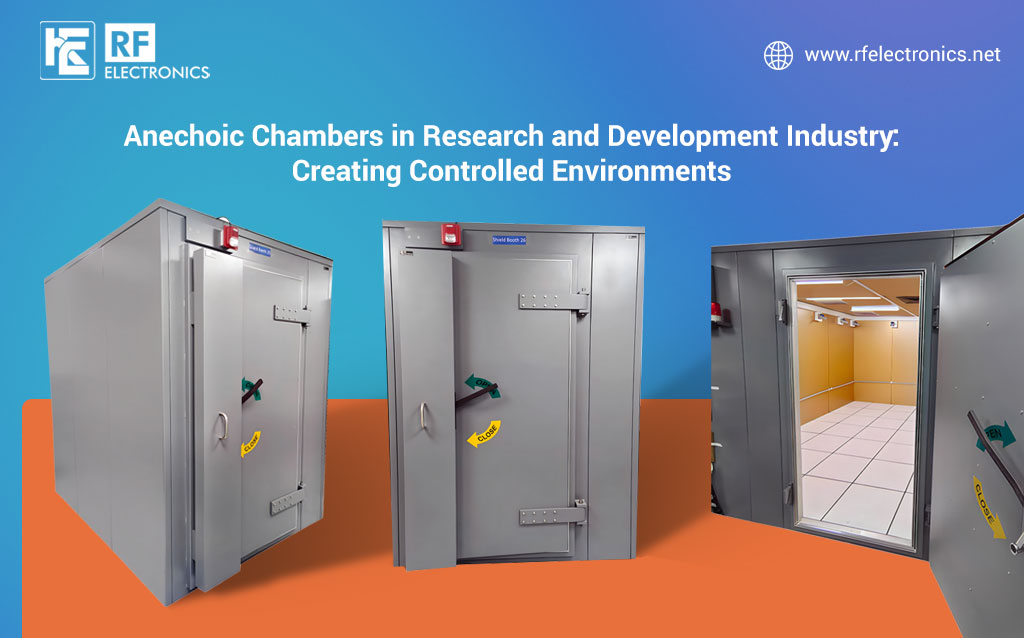
In the fast-paced domain of research and development (R&D), precision and control are crucial. Scientists and engineers frequently depend on specialized facilities called
anechoic chambers to attain accurate results in experiments. These chambers offer controlled environments devoid of external interference. This enables researchers to conduct experiments with utmost accuracy and reliability. Let us explore the functionality of anechoic chambers, their applications in R&D, the advantages they provide, and their role in establishing controlled testing environments.
How Anechoic Chambers Work
Anechoic chambers are designed to minimize the reflection of electromagnetic waves, sound waves, or vibration within their confines. The term "anechoic" originates from the Greek words "an," meaning without, and "echo," referring to reflected sound. These chambers achieve their unique properties through specialized construction techniques.
The walls, floor, and ceiling of an anechoic chamber are lined with materials that absorb electromagnetic waves or sound, such as specialized foam or ferrite tiles. This absorption prevents waves from bouncing off surfaces and interfering with experiments. To make it easier to understand, imagine the walls of the chamber acting like giant sponges soaking up any waves that come their way. Additionally, the chamber's design often includes specific shapes and configurations, further minimizing reflections.
Applications in Research and Development
The applications of anechoic chambers in research and development (R&D) are incredibly diverse and essential across various industries. Here are some key applications:
1. Antenna Testing: Anechoic chambers are extensively used for testing antennas in industries such as telecommunications, aerospace, and automotive. Engineers can evaluate antenna performance, including radiation patterns, gain, and impedance, without external interference.
2. Electromagnetic Compatibility (EMC) Testing: Anechoic chambers facilitate
EMC testing by isolating electronic devices from external electromagnetic interference. This allows researchers to assess the device's emissions and susceptibility to interference accurately.
3. Acoustic Research: Anechoic chambers are also utilized in acoustic research to study sound propagation, noise reduction, and audio equipment testing. By creating environments free from sound reflections, researchers can accurately measure parameters such as sound pressure levels, frequency response, and reverberation time.
4. Wireless Communication Testing: In the development of wireless communication systems, anechoic chambers play a vital role in characterizing antennas, transmitters, and receivers. Engineers can assess parameters like signal strength, bandwidth, and interference rejection in a controlled environment.
5. Satellite and Radar Testing: Anechoic chambers are indispensable for testing satellite payloads, radar systems, and other RF (radio frequency) electronics. These chambers simulate space or atmospheric conditions, allowing engineers to evaluate the performance of satellite communication systems and radar sensors accurately.
6. Medical Device Testing: In the medical field, anechoic chambers are used to test the electromagnetic compatibility and safety of medical devices such as MRI machines, pacemakers, and implantable devices. By subjecting these devices to controlled electromagnetic environments, researchers can assess their performance and susceptibility to interference, ensuring patient safety and regulatory compliance.
The Role of Anechoic Chambers in Creating Controlled Testing Environments
Anechoic chambers play a pivotal role in creating controlled testing environments for R&D purposes. By eliminating external interference, these chambers enable researchers to isolate and study specific phenomena with precision. Whether testing antennas, evaluating electromagnetic compatibility, or conducting acoustic experiments, the controlled environment of an anechoic chamber ensures the accuracy and reproducibility of results.
Anechoic chambers serve as critical assets in establishing controlled testing environments within the realm of research and development (R&D). Their significance lies in their ability to eliminate external interference, thereby providing researchers with a meticulously controlled setting to conduct experiments. Here is how anechoic chambers contribute to creating such environments:
1. Isolation of External Factors: Anechoic chambers effectively shield experiments from external electromagnetic waves, sound, and vibrations. This isolation ensures that the phenomena under investigation remain undisturbed by unwanted external influences.
-
Electromagnetic Shielding: The specialized construction of anechoic chambers, including walls lined with materials that absorb electromagnetic waves, prevents interference from external sources such as radio signals or electrical equipment.
-
Sound Absorption: By utilizing materials engineered to absorb sound, anechoic chambers create environments where acoustic experiments can be conducted without the intrusion of ambient noise or reverberation.
2. Precision and Reproducibility: The controlled environment offered by anechoic chambers enhances the precision and reproducibility of experimental results.
-
Antenna Testing: In antenna testing, for instance, the absence of external electromagnetic interference allows researchers to precisely measure parameters such as radiation patterns and gain, ensuring accurate characterization of antenna performance.
-
EMC Evaluation: When evaluating electromagnetic compatibility, anechoic chambers provide a stable environment for assessing the emissions and susceptibility of electronic devices, enabling researchers to reliably verify compliance with regulatory standards.
3. Enhanced Accuracy: By minimizing reflections and external disturbances, anechoic chambers contribute to the accuracy of measurements and observations.
-
Acoustic Research: In acoustic experiments, the absence of sound reflections within anechoic chambers ensures that measurements of parameters such as sound pressure levels and frequency response are accurate, facilitating the development of noise control solutions and audio equipment.
In the fast-paced world of research and development, the ability to create controlled environments is indispensable. Anechoic chambers serve as invaluable tools for researchers, providing the means to conduct experiments with precision and reliability. By minimizing external interference and reflections, these chambers enable scientists and engineers to delve deeper into their research, driving innovation across various fields. As technology continues to evolve, the role of anechoic chambers in R&D is likely to remain essential, facilitating breakthroughs and advancements in science and engineering.
RF Electronics is a leading provider of RF shielding(RF isolation)) solutions, anechoic chambers, and related products. With a commitment to excellence and innovation, we specialize in delivering high-quality shielding devices and controlled environments that meet the diverse needs of research, development, and testing industries.


